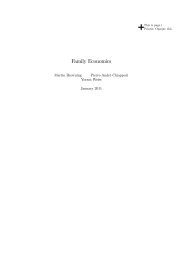Bounded Rationality in Industrial Organization
Bounded Rationality in Industrial Organization
Bounded Rationality in Industrial Organization
You also want an ePaper? Increase the reach of your titles
YUMPU automatically turns print PDFs into web optimized ePapers that Google loves.
of-thumb approach over the rational approach on the grounds that “it seems implausible<br />
to assume that households actually compute optimal solutions to a large number of difficult<br />
game-theoretic and <strong>in</strong>formation-theoretic problems.” Part of his argument for this<br />
contention is that “buyers’ optimal use of the signals transmitted by firms’s choices of<br />
advertis<strong>in</strong>g levels would depend on the strategies be<strong>in</strong>g employed by all sellers.” With<strong>in</strong><br />
just a few years, the mechanics of solv<strong>in</strong>g such signall<strong>in</strong>g problems had become so rout<strong>in</strong>e<br />
that I am sure few economists presented with this latter quote would have guessed that it<br />
was meant as a critique of signall<strong>in</strong>g theory rather than as an exposition of how to solve<br />
signall<strong>in</strong>g problems.<br />
3.2 Explicit bounded rationality<br />
Although Simon’s <strong>in</strong>itial motivation of bounded rationality leaned very heavily on limited<br />
human capacity for computation, the theory mostly developed along l<strong>in</strong>es that had little<br />
to do with this. Agents were assumed to satisfice rather than to maximize, but there was<br />
little attempt to formalize why this might be easier than maximiz<strong>in</strong>g or to provide criterion<br />
on which to assess the feasibility of other behaviors.<br />
One place <strong>in</strong> which computational limitations were made explicit was <strong>in</strong> team theory. 2<br />
In the canonical model of this literature, a firm is modeled as a group of agents shar<strong>in</strong>g<br />
a common objective. The firm needs to choose a vector-valued action. Which action is<br />
optimal depends on an unknown state of nature. Each employee has some <strong>in</strong>formation.<br />
The problem of choos<strong>in</strong>g an optimal action is complicated by the presence of two additional<br />
costs: each agent may <strong>in</strong>cur a cost of gather<strong>in</strong>g <strong>in</strong>formation; and there may be costs<br />
of communicat<strong>in</strong>g <strong>in</strong>formation across agents. Given these <strong>in</strong>formation costs, it will generally<br />
not be optimal to gather all the available <strong>in</strong>formation, nor to convey what has been<br />
gathered to a s<strong>in</strong>gle decision maker. Instead, the firm may want to decentralize decisionmak<strong>in</strong>g<br />
and have agents or groups of agents choose components of the vector-valued action<br />
<strong>in</strong>dependently.<br />
Mak<strong>in</strong>g decisions accord<strong>in</strong>g to the optimal decentralized procedure is, of course, the<br />
2 See Marschak and Radner (1972).<br />
8













